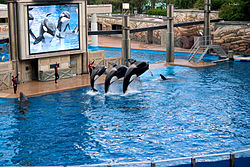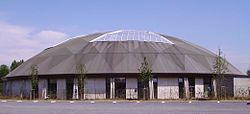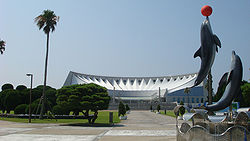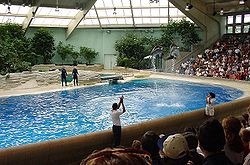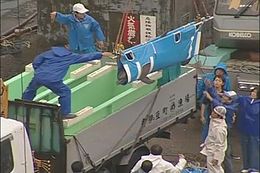- Dolphinarium
-
A dolphinarium is an aquarium for dolphins. The dolphins are usually kept in a large pool, though occasionally they may be kept in pens in the open sea, either for research or for public performances. Some dolphinariums consist of one pool where dolphins perform for the public, others are part of larger parks, such as marine mammal parks, zoos or theme parks, keeping other animals and having other attractions as well.
While cetaceans have been held in captivity since the 1860s, the first commercial dolphinarium was opened only in 1938. Their popularity increased rapidly until the 1960s.[1] Since the 1970s, increasing concern for animal welfare led to stricter regulation, which in several countries ultimately resulted in the closure of all dolphinariums in the past decades.[2] Despite this trend, dolphinariums are still widely spread in Europe, Japan and North America.
The most common species of dolphin kept in dolphinariums is Bottlenose Dolphins as they are relatively easy to train and have a long lifespan in captivity. While the trade in dolphins is internationally regulated, other aspects of keeping dolphins in captivity such as the minimum size and characteristics of pools vary among countries.[3] Though animal welfare is perceived to have improved significantly over the last few decades, many animal rights and welfare groups still consider keeping dolphins captive to be a form of animal abuse.
Contents
History
Though cetaceans have been held in captivity in both North America and Europe since the 1860s, the first being a pair of Beluga Whales in the New York museum, dolphins were first kept for paid entertainment in the Marine Studios dolphinarium founded in 1938 in St. Augustine, Florida. It was here that it was discovered that dolphins could be trained to perform tricks. Recognizing the success of Marine Studios, more dolphinariums keeping dolphins for entertainment followed.[1] In the 1960s, keeping dolphins in zoos and aquariums for entertainment purposes increased in popularity after the 1963 Flipper movie and subsequent Flipper television series. In 1966, the first dolphin was exported to Europe. In these early days, dolphinariums could grow quickly due to a lack of legislation and lack of concern for animal welfare.
New legislation, most notably the 1972 Marine Mammal Protection Act in the United States, combined with a more critical view on animal welfare forced many dolphinariums around the world to close. In 1985 Australia banned the display of all cetaceans.[2] Another prominent example is the United Kingdom, where despite that during the early 1970s there were at least 36 dolphinariums and travelling dolphin shows, the last dolphinarium closed its doors in 1993.[4] The last dolphinarium in Hungary was closed in 1992, and any future dolphin imports were prohibited.[2] In 2005 both Chile and Costa Rica prohibited keeping cetaceans captive.[3] However, around 60 dolphinariums currently exist across Europe of which 34 within the EU.[5] Japan, Mexico and the United States are also home to a relatively large number of dolphinariums.
Design
Many varied designs exist, but an often found basic dolphinarium design for public performances consists of stands for the public around a semi-circular pool, sometimes with glass walls which allow underwater viewing, and a platform in the middle from which the trainers direct and present the show.
The water in the pools has to be constantly filtered to keep it clean for the dolphins and the spectators, and the temperature and composition of the water has to be controlled to match the conditions dolphins experience in the wild. In the absence of a common international regulation, guidelines regarding the minimum size of the pools vary between countries.[3] To give an indication of pool sizes, the European Association for Aquatic Mammals recommends that a pool for five dolphins should have a surface area of 275 m2 (2,960 sq ft) plus an additional 75 m2 (810 sq ft) for every additional animal, have a depth of 3.5 m (11 ft) for at least the minimum surface area and have a water volume of at least 1,000 m3 (35,000 cu ft) with an additional 200 m3 (7,100 cu ft) for every additional animal. If two of these three conditions are met and the third is not more than 10% below standard, the EAAM considers the pool size to be acceptable.[6]
Animals
Species
Various species of dolphins are kept in captivity and also several other small whale species such as Harbour Porpoises, Finless Porpoises and Belugas, though in those cases the word dolphinarium may not be fitting as these are not true dolphins. Bottlenose Dolphins are the most common species of dolphin kept in dolphinariums: they are relatively easy to train, have a long lifespan in captivity and a friendly appearance. Hundreds if not thousands of Bottlenose Dolphins live in captivity across the world, though exact numbers are hard to give. Orcas are well known for their performances in shows, but the number of Orcas kept in captivity is very small especially when compared to the number of bottlenose dolphins, with only 41 captive Orcas being known as of 2007.[7] Of all Orcas kept in captivity, the majority are located in the various SeaWorld parks in the United States. Other species kept in captivity are Spotted Dolphins, False Killer Whales and Common Dolphins, Commerson's Dolphins, and Rough-toothed Dolphins, but all in much lower numbers than the Bottlenose Dolphin. Also kept, but in numbers of less than ten are Pilot Whales, Amazon River Dolphins, Risso's Dolphins, Spinner Dolphins, and Tucuxi. Two unusual and very rare hybrid dolphins known as Wolphins are kept at the Sea Life Park in Hawaii, which are a cross between a Bottlenose Dolphin and a False Killer Whale. Also two Common/Bottlenose hybrids reside in captivity one at Discovery Cove and the other SeaWorld San Diego.
Trade and capture
In the early days, many bottlenose dolphins were wild caught off the coast of Florida where they are common. Though the Marine Mammal Protection Act, established in 1972, allows an exception for the collection of dolphins for public display and research purposes providing a permit is obtained, Bottlenose dolphins have not been captured in American waters since 1989. In most Western countries, breeding programmes have been set up to provide the dolphinariums with new animals. To achieve a sufficient birth rate and to prevent inbreeding, artificial insemination (AI) is occasionally used. The use of AI also allows dolphinariums to increase the genetic diversity of their population without having to bring in any dolphins from other facilities.
The trade of dolphins is regulated by CITES. Endangered dolphin species are included in CITES’ Appendix I, in which case trade is permitted only in exceptional circumstances. Species considered not to be threatened with extinction are included in Appendix II, in which case trade “must be controlled in order to avoid utilization incompatible with their survival”. Most cetacean species traded for display in captivity to the public or for use in swimming with dolphins and other interaction programmes are listed on Appendix II.[3]
Live dolphins are still traded however. A live Bottlenose Dolphin is estimated to cost between a few thousand and several tens of thousands of US dollars, depending on age, condition and prior training. Captures are reported to be on the rise in the South Pacific and the Caribbean,[8] Cuba has also been an exporter of dolphins in recent years, this being organised by the Acuario Nacional de Cuba.[9] In recent years, the Solomon Islands have also allowed the collection and export of dolphins for public display facilities.[10] A 2005 law banned the export of dolphins,[11] however this ban has been seemingly overturned when in 2007 some 28 dolphins were shipped to Dubai.[12] Some, mainly Japanese, dolphinariums obtain their dolphins from local drive hunts, though several other countries in Asia also import dolphins from Japan. Several American dolphinariums have also done so in the past, however not since 1993 when the US National Marine Fisheries Service refused a permit for Marine World Africa USA to import four False Killer Whales caught in a Japanese drive hunt.
Criticism
Animal welfare
Though animal welfare is perceived to have improved significantly over the last few decades, many animal rights and welfare groups such as the WSPA still consider keeping dolphins at dolphinariums a form of animal abuse. The main arguments are that dolphins do not have enough freedom of movement in pools, regardless of pool size, (in the wild, dolphins swim hundreds of miles every day) and do not get enough stimulation. Dolphins often show repetitive behavior in captivity and sometimes become aggressive towards other animals or people. In some cases, the behavior of dolphins in captivity also results in their own death.[13]
The lifespan of dolphins in captivity is another subject of debate. Research has shown that Orcas indeed have a much lower survival rate in captivity;[14] however, there is no significant difference between wild and captive survival rates for Bottlenose dolphins.[15] This does not, however, reflect a global state of affairs: for example, Bottlenose dolphins in captive facilities in Jamaica suffer from extremely high mortality rates.[16]
In response to criticism, dolphinariums often stress that every effort is being made to ensure the well-being of the animals, who are being cared for with state-of-the-art medical technology (including some adapted from that used for humans). Many dolphinariums are also involved in research and education programs, assist in cases of beachings, and provide aid to sick or injured wild animals.
In 2003, Jane Tipson, an animal rights activist working in Saint Lucia was murdered in an apparent contract killing alleged to be related to her work against the establishment of new dolphinariums in the Caribbean.
As health therapy
Captive dolphins are an increasingly popular choice of animal-assisted therapy for humans with psychological problems and developmental disabilities. For example, a 2005 study of 30 participants found that dolphin-assisted therapy was an effective treatment for mild to moderate depression.[17] However, this study was criticized on several grounds: for example, it is not known whether dolphins are more effective than common pets.[18] Reviews of this and other published dolphin-assisted therapy (DAT) studies have found important methodological flaws, leading reviewers to conclude that there is no compelling scientific evidence that DAT is a legitimate therapy, or that it affords any more than fleeting improvements in human mood.[19]
See also
Notes
- ^ a b "Following P.T. Barnum's ill-fated display of white whales in his New York Museum in 1860, it was not until 1913 that cetaceans were again seen in captivity, this time when C. H. Townsend, curator of the New York Aquarium, stumbled upon the idea exhibiting dolphins as an unbeatable novelty to attract the crowds.", "During feeding time at Marine Studios, it is said, dolphins gradually fell into the habit of jumping up to catch the fish that were thrown to them, and this miniature spectacle always amused the public, the keepers and curator. Then a year later in 1939, Cecil M. Walker, then responsible for maintenance of the water purification pumps on the night-shift, observed one evening how a dolphin pushed a pelican feather across the surface of the water towards him. "Just for the hell of it" he took the proffered feather and threw it back into the water, whereupon, to his great surprise, the dolphin brought it back again. The game continued with Walker experimenting with a ball, an inner tube of a bicycle, small stones and other objects. As the game took shape with other dolphins joining in the act, it began to resemble the repertoire seen today in every dolphinarium in the world.", quotes from The rose-tinted menagerie.
- ^ a b c Wild for dolphins: Legislative requirements, retrieved November 16, 2009
- ^ a b c d UNEP:Guidelines and criteria associated with marine mammal captivity (2006) [1], retrieved 22 November, 2009
- ^ "In the golden heyday of the industry, there were at least 36 assorted dolphinaria or itinerant dolphin shows in the UK.", quote from The rose-tinted menagerie
- ^ Oceancare:Dolphinariums in Europe, retrieved November 16, 2009
- ^ Recommended EAAM dolphin housing standards, retrieved 22 November, 2009
- ^ Orcas in Captivity - A look at killer whales in aquariums and parks (when viewed 23rd of November 2009)
- ^ The Humane Society: Held Captive: Developing Nations, (2009), retrieved 22 November, 2009
- ^ "But it is in Fidel Castro's revolutionary Cuba that dolphin catching in South America has been given a new lease of life, under the auspices of the quasi state-run enterprise Acuario Nacional.", quote from The rose-tinted menagerie
- ^ HONIARA, Solomon Islands (Reuters) - A cargo plane arrived in the lawless Solomon Islands Monday to pick up wild dolphins captured to order for a Mexican syndicate in what activists have blasted as an environmental crime, regional media reported. Developments on dolphin capture
- ^ Solomon Islands law banning the export of dolphins
- ^ The Associated Press / International Herald Tribune Solomon Islands dolphins exported to Dubai; protests mount, article retrieved October 25, 2007.
- ^ WSPA: Dolphins in captivity, retrieved 23 November 2009.
- ^ Orcanetwork:Survival rates in captivity, retrieved November 19, 2009
- ^ Willis, K. 2007. "Life Expectancy of Bottlenose Dolphins in Alliance of Marine Mammal Parks and Aquariums' North American Member Facilities: 1990 - present". Presented at the 2007 meeting of the Alliance of Marine Mammal Parks and Aquariums.
- ^ Environmental Management Consultants Ltd. (2007), Review of the Environmental Impact Assessment (EIA) For the Proposed Dolphin Park in Paradise, Hanover, page 3, section Mortalities. Article retrieved November 20, 2009.
- ^ Christian Antonioli and Michael A. Reveley, (2005), Randomised controlled trial of animal facilitated therapy with dolphins in the treatment of depression.
- ^ Biju Basil, Maju Mathews (2005). "Methodological concerns about animal facilitated therapy with dolphins". BMJ 331 (7529): 1407. doi:10.1136/bmj.331.7529.1407. PMC 1309662. PMID 16339258. http://www.bmj.com/cgi/content/full/331/7529/1407.
- ^ Marino L, Lilienfeld SO (2007). "Dolphin-Assisted Therapy: more flawed data and more flawed conclusions" (PDF). Anthrozoos 20 (3): 239–49. doi:10.2752/089279307X224782. http://www.marineconnection.org/docs/DAT%20Paper%202007.pdf. Retrieved 2008-02-20.
Further reading
Johnson, William (April 1994). The Rose-tinted Menagerie. Heretic Books. ISBN 978-0946097289. http://www.iridescent-publishing.com/rtm_home.htm.
External links
Zoos, aquariums, and aviaries Types of zoos - Animal sanctuary
- Animal theme park
- Aquarium
- Aviary
- Bear pit
- Butterfly zoo
- Dolphinarium
- Oceanarium
- Herpetarium
- Insectarium
- Nature center
- Marine mammal park
- Menagerie
- Night safari
- Oceanarium
- Pheasantry
- Petting zoo
- Reptile centre
- Safari park
- Serpentarium
- Virtual zoo
- Vivarium
- Zoo
Conservation Lists Animals Other topics - Animals in captivity
- Animal training
- Behavioral enrichment
- Captive breeding
- Frozen zoo
- Immersion exhibit
- Nocturnal house
- Wildlife conservation
- Zookeeper
- Zoology
- Portal
- Project
- Category
- Commons
Categories:- Aquaria
- Animal welfare
- Cetaceans
- Dolphins
Wikimedia Foundation. 2010.

